Today, it’s essential to optimize a brand’s location for search, traffic, and discovery. If you have to find a cafeteria or a designer store, you can simply check on the store locator and find out the location. You will get the mobile version, and that’s precisely how local searches take place these days.
Alternatively, you can also make use of Apple, Bing or Google Map apps. Additionally, you could also check Foursquare, Yelp and Facebook Places as well. And what’s even more interesting to note today, is that you type in designer store or coffee shop in the search engine and you will find store location options for a set of brands that you choose to concentrate. So, if you want to be successful in local SEO, then the solution is to blend in both services and technology. And if you are wondering how to go about it, you can try out the five steps that are as follows:
- Store Locator
The basis of a good local SEO strategy has a store locator. About a decade back, it used to be an afterthought. But in today’s mobile era and age of digital boom, the store locators are essential for a brand. It must stand by the brand promise. It indicates that it is much more than a basic zip-code look up, having an address list. Store locator tools enable the customers to locate the closest store matching the category they searched for. These tools come with a responsive design. And all these tools are completely integrated into the primary social and search networks. Every page shows the distinctive community that store caters to. You can browse through l.a SEO Experts company to know more about this.
- Location data platform
A store locator needs to host a company’s location data of the record. It indicates that it is the most precise, compact and existing data set for a company’s store. The Geocode for every location should be set manually atop the building. There’s no way to get that correct. The remaining address, as well as the contact data, needs to get updated every week. The moment this is done, the precise data gets syndicated to Bing, Google, Foursquare, Facebook and many other directories on a daily basis. Finally, the third-party listings and the pages that are required for linking back to the respective store locator page and is inter-linked.
- Social media optimization
The social channels today play an important role in local search results. Furthermore, Google’s algorithm makes use of social signals, like comments, likes, ratings, shares, reviews and the like to evaluate the popularity and significance of the location process, all through the overall local ecosystem, essential with the advent of Google+ Local pages. Google also makes use of such signals to rank a coffee shop, a designer boutique, retailer and the like. When a brand appears more locally significant, the more are its chances to get high ranks in the search results. Naturally, such brands will draw in more a higher amount of web traffic as well.
- Reputation management is essential
The customer ratings and reviews act as a double-edged sword. But it can’t be ignored at all. The popular channels at a local level include Yelp, Facebook as well as Google +. Furthermore, the multi-location brands initially require a tactic to aggravate this whole content in real-time with the capacity to sort-out reviews at a regional, store and national level. After this, they will have to get engaged to let them know the audience that they are listening. It could be by replying to negative feedback or by liking a comment posted by a user. When you can effectively manage the local reviews, you will be able to maximize the search traffic and also increase the overall rating by the brand. When customers know that a brand is paying attention, they will write in neutral to positive reviews.
- Advertising
The moment an ecosystem gets sorted, brands boost results using paid media both on Facebook and on Google. Every platform supports localized ads, but from the opposite angles, for instance once is proactive like Facebook News Feed and the other is reactive such as Google search results. One of the smart processes is opting in for the Facebook Local Awareness and the ad objective. Here you have a collection of distinctive ads available on a per-location basis that can generate foot traffic to a physical location via the “Get Directions” CTA (Call to actions).
Additionally, it can also drive the website traffic to the Facebook Local Page, Google + Local Page via a web link. It helps to generate an intended action, such as visiting or calling the store. Furthermore, it also assists the local SEO via the traffic and engagement right at the store level. For more information, get in touch with l.a SEO Experts company.
Local SEO is essential in getting your brand noted amongst your existing and potential customers. You can start by following these five steps discussed above. Later as you progress, you can move to other local SEO strategies based on your requirement and company growth.
